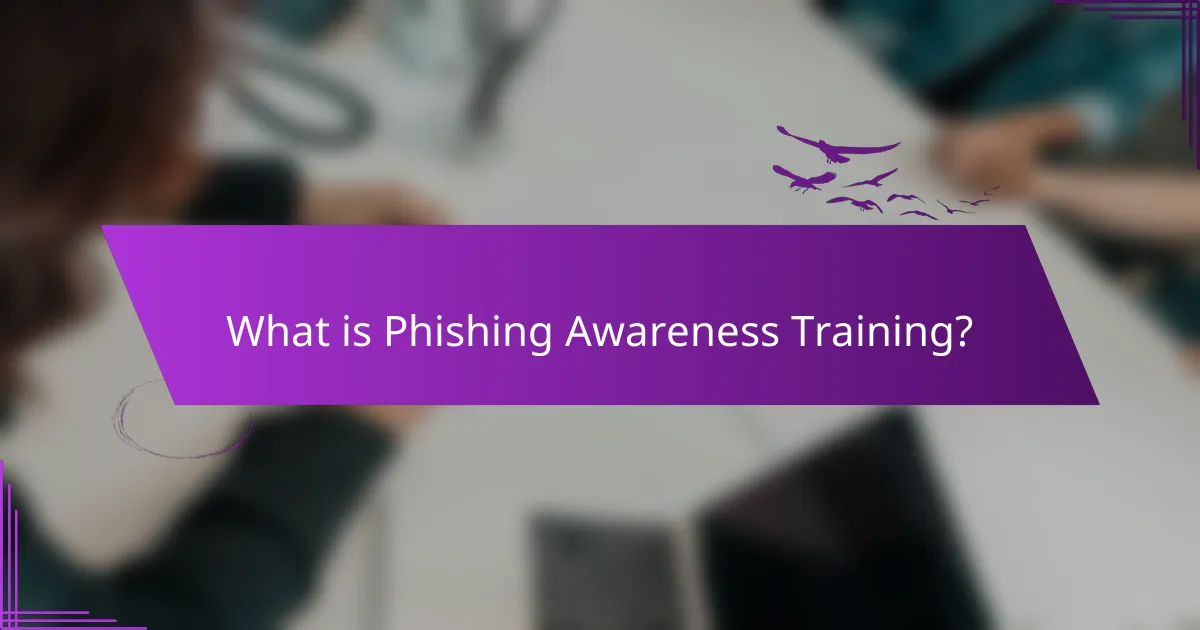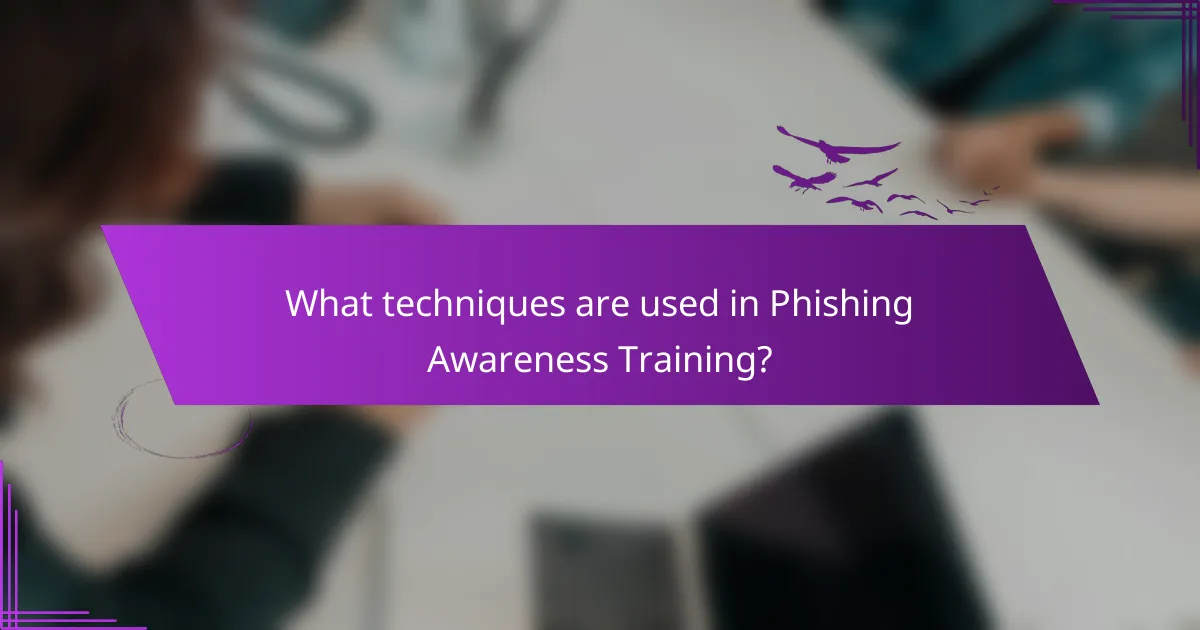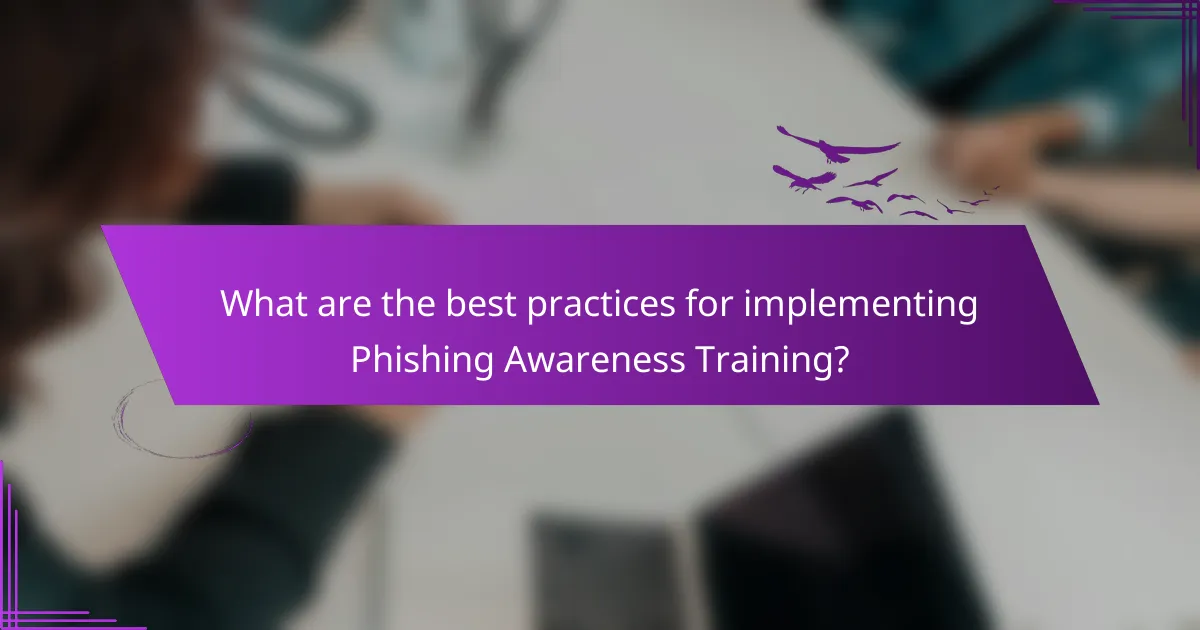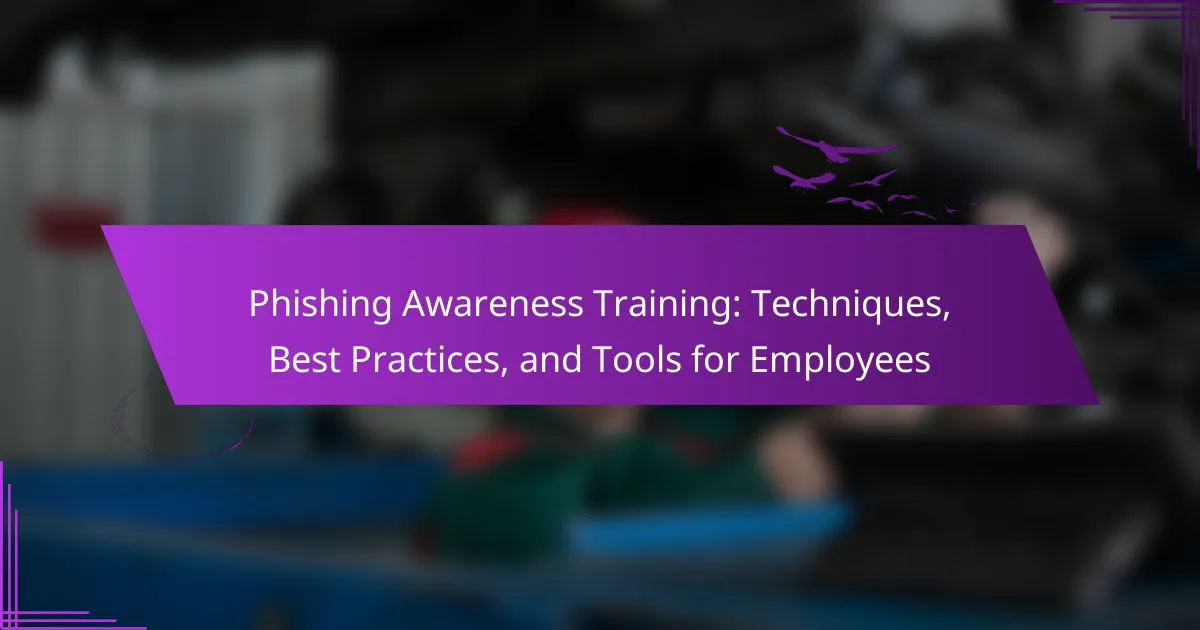
What is Phishing Awareness Training?
Phishing awareness training is an educational program designed to inform employees about phishing threats. It teaches individuals how to recognize, avoid, and report phishing attempts. Participants learn about various phishing techniques, such as email spoofing and deceptive links. The training often includes real-world examples of phishing attacks. It aims to reduce the risk of successful phishing incidents within organizations. Studies show that effective training can decrease the likelihood of employees falling victim to such attacks. Organizations implementing phishing awareness training typically see improved security awareness among staff. This training is essential in today’s digital landscape, where phishing attacks are increasingly common.
How does Phishing Awareness Training benefit employees?
Phishing Awareness Training benefits employees by enhancing their ability to recognize and respond to phishing attempts. This training educates employees about common phishing tactics, such as deceptive emails and fraudulent websites. It equips them with practical skills to identify suspicious communications. Research shows that organizations with phishing training reduce successful phishing attacks by up to 70%. Increased awareness leads to improved security practices among employees. As a result, employees become a stronger line of defense against cyber threats. Ultimately, this training fosters a culture of security within the organization.
What are the key components of effective Phishing Awareness Training?
Effective phishing awareness training includes several key components. These components are crucial for enhancing employee knowledge and reducing vulnerability to phishing attacks. First, training should cover the identification of phishing attempts. Employees must learn to recognize common signs, such as suspicious email addresses and unexpected attachments.
Second, real-world examples of phishing attacks are essential. Sharing case studies helps employees understand the tactics used by attackers. Third, interactive training methods, such as simulations, engage employees more effectively. Simulated phishing attacks can provide hands-on experience in identifying threats.
Fourth, ongoing training is vital. Regular updates ensure employees stay informed about evolving phishing tactics. Lastly, clear reporting procedures should be established. Employees need to know how to report suspected phishing attempts promptly. These components collectively create a robust phishing awareness training program.
How does employee engagement influence the effectiveness of training?
Employee engagement significantly enhances the effectiveness of training. Engaged employees are more likely to actively participate in training sessions. This active participation leads to better retention of information. Research indicates that engaged employees retain 50% more information than their disengaged counterparts. Furthermore, high engagement levels contribute to a positive learning environment. This environment encourages collaboration and knowledge sharing among employees. Consequently, training programs become more impactful and relevant. Overall, employee engagement directly correlates with improved training outcomes.
Why is Phishing Awareness Training essential in today’s workplace?
Phishing awareness training is essential in today’s workplace to protect sensitive information and reduce security risks. Organizations face increasing threats from phishing attacks, which can lead to data breaches and financial losses. According to the 2022 Verizon Data Breach Investigations Report, 82% of data breaches involved a human element, highlighting the importance of employee training. Effective training programs educate employees on identifying phishing attempts and responding appropriately. This proactive approach can significantly decrease the likelihood of successful attacks. Investing in phishing awareness training fosters a security-conscious culture within the organization, ultimately safeguarding its assets.
What are the potential consequences of inadequate phishing awareness?
Inadequate phishing awareness can lead to significant security breaches. Employees may fall victim to phishing attacks, resulting in compromised sensitive information. This can include financial data, personal identification, and corporate secrets. According to the 2021 Verizon Data Breach Investigations Report, phishing is involved in 36% of data breaches. Moreover, organizations may face financial losses due to fraud and recovery costs. Inadequate awareness can also damage a company’s reputation. Customers and partners may lose trust if their data is mishandled. Ultimately, the lack of phishing awareness can result in legal implications and regulatory fines.
How do phishing attacks impact organizational security?
Phishing attacks significantly undermine organizational security by compromising sensitive data and systems. These attacks often involve deceptive emails that trick employees into revealing credentials. As a result, unauthorized access to corporate networks may occur. A 2021 report by the Anti-Phishing Working Group noted that phishing incidents increased by 22% compared to the previous year. This rise leads to financial losses, with the average cost of a data breach reaching $4.24 million in 2021, according to IBM. Additionally, phishing can damage an organization’s reputation and erode customer trust. Organizations may also face regulatory penalties for data breaches stemming from phishing attacks. Overall, phishing attacks pose a critical threat to the integrity and security of organizational assets.

What techniques are used in Phishing Awareness Training?
Phishing awareness training employs various techniques to educate employees. These techniques include simulated phishing attacks to test employee responses. Interactive training modules engage employees through quizzes and scenarios. Real-life case studies illustrate the impact of phishing attacks on organizations. Regular updates on phishing trends keep training relevant and current. Gamification elements improve engagement and retention of information. Feedback mechanisms allow employees to learn from mistakes during simulations. Comprehensive assessments evaluate the effectiveness of the training program.
How can simulations enhance phishing awareness among employees?
Simulations can enhance phishing awareness among employees by providing realistic, hands-on experiences. These simulations mimic actual phishing attacks, allowing employees to recognize and respond to threats in a controlled environment. By engaging in these exercises, employees learn to identify common signs of phishing attempts, such as suspicious email addresses and urgent requests for personal information. Research shows that organizations using phishing simulations experience a 30% reduction in successful phishing attacks. This practical training reinforces theoretical knowledge and builds confidence in handling real threats. Overall, simulations create a proactive culture of cybersecurity awareness among employees.
What types of phishing simulations are most effective?
Phishing simulations that are most effective include spear phishing, whaling, and vishing simulations. Spear phishing targets specific individuals, increasing the likelihood of success. Whaling focuses on high-profile targets like executives, making it particularly impactful. Vishing involves voice phishing, simulating phone-based attacks to assess employee responses. Research shows that targeted simulations improve awareness and response rates. A study by the Ponemon Institute found that organizations using targeted phishing simulations reduced successful phishing attacks by 78%. Effective simulations are tailored to the organization’s specific threats and employee roles.
How do employees typically respond to phishing simulations?
Employees typically respond to phishing simulations by clicking on simulated phishing links. Research shows that around 30% of employees may click on these links during initial tests. However, after receiving training, this percentage often decreases significantly. Many employees express increased awareness of phishing tactics after simulations. They report feeling more cautious when handling suspicious emails. Follow-up assessments indicate improved recognition of phishing attempts. This suggests that simulations effectively enhance employees’ ability to identify real threats. Overall, the response to phishing simulations indicates a positive trend in phishing awareness.
What interactive methods are effective in teaching phishing awareness?
Interactive methods effective in teaching phishing awareness include simulated phishing attacks, gamified learning, and scenario-based training. Simulated phishing attacks allow employees to experience real-life phishing attempts in a controlled environment. This method helps identify vulnerabilities and reinforces learning through immediate feedback. Gamified learning incorporates elements of games, such as points and rewards, to engage users and enhance retention of information. Scenario-based training presents realistic situations that require employees to make decisions, improving critical thinking skills related to phishing threats. Research shows that these interactive methods significantly improve retention rates and awareness of phishing tactics among employees.
How do gamification strategies improve learning outcomes?
Gamification strategies improve learning outcomes by increasing engagement and motivation among learners. These strategies incorporate game-like elements, such as points, badges, and leaderboards, into educational content. This approach encourages participation and fosters a competitive spirit. Research shows that gamification can enhance retention rates by making learning more enjoyable. A study published in the Journal of Educational Psychology found that students who experienced gamified learning environments scored 14% higher on assessments than those in traditional settings. Gamification also promotes immediate feedback, which aids in knowledge retention and skill application. Overall, these strategies create a dynamic learning experience that can lead to better educational results.
What role do real-life case studies play in training sessions?
Real-life case studies play a crucial role in training sessions by providing practical examples of phishing incidents. They illustrate the tactics used by attackers and the consequences of falling victim. Participants can analyze these cases to identify vulnerabilities and recognize warning signs. This analysis fosters critical thinking and enhances retention of information. Research shows that experiential learning increases engagement and understanding. According to a study by the Association for Talent Development, 70% of learning occurs through experience. Case studies also facilitate discussion and collaboration among participants, promoting a deeper understanding of the subject matter. Overall, they serve as effective tools to bridge theory and practice in phishing awareness training.

What are the best practices for implementing Phishing Awareness Training?
The best practices for implementing Phishing Awareness Training include conducting regular training sessions, utilizing real-life examples, and testing employees with simulated phishing attacks. Regular training ensures that employees stay updated on the latest phishing tactics. Utilizing real-life examples helps employees recognize common phishing signs. Simulated phishing attacks provide practical experience and reinforce training concepts. Additionally, providing clear reporting procedures encourages employees to report suspicious emails. Tracking and measuring training effectiveness is essential for ongoing improvement. Finally, fostering a culture of security awareness promotes vigilance among employees. These practices significantly reduce the risk of successful phishing attacks.
How often should Phishing Awareness Training be conducted?
Phishing Awareness Training should be conducted at least annually. Regular training helps employees recognize and respond to phishing attempts effectively. According to the Cybersecurity & Infrastructure Security Agency, annual training is a baseline recommendation. Some organizations may benefit from more frequent training, such as quarterly or biannual sessions. This frequency can reinforce knowledge and adapt to evolving phishing tactics. Continuous updates and simulations can further enhance employee awareness and preparedness.
What factors influence the frequency of training sessions?
The frequency of training sessions is influenced by several factors. Organizational policies dictate how often training occurs. Regulatory requirements may mandate specific training intervals. Employee turnover rates can necessitate more frequent training sessions. The evolving nature of phishing threats requires regular updates. Additionally, employee performance metrics may indicate the need for refresher courses. Finally, available resources, including time and budget, also play a significant role in determining training frequency.
How can organizations assess the effectiveness of their training programs?
Organizations can assess the effectiveness of their training programs through various evaluation methods. One method is the use of surveys to gather participant feedback. Surveys can measure knowledge retention and satisfaction levels. Another approach is conducting pre- and post-training assessments. These assessments can quantify knowledge gains and skill improvements.
Additionally, organizations can track performance metrics related to phishing incidents. A decrease in successful phishing attempts can indicate effective training. Observational assessments during simulations can also provide insights into employee behavior.
Finally, analyzing long-term retention through follow-up assessments can determine the lasting impact of training. Research shows that regular evaluations enhance training efficacy. This structured approach ensures organizations can continuously improve their training programs.
What resources are available for developing Phishing Awareness Training?
Resources for developing Phishing Awareness Training include online courses, instructional videos, and interactive simulations. Organizations can utilize platforms like KnowBe4 and Proofpoint for comprehensive training modules. Additionally, the Anti-Phishing Working Group provides valuable materials and guidelines. The Federal Trade Commission offers resources to educate employees on recognizing phishing attempts. Research from the Ponemon Institute highlights that effective training reduces phishing susceptibility by up to 70%. These resources collectively support effective phishing awareness initiatives.
What tools can organizations use to create training content?
Organizations can use various tools to create training content. Common tools include Learning Management Systems (LMS) like Moodle and TalentLMS. These platforms allow for content creation, tracking, and reporting on employee progress. Authoring tools such as Articulate Storyline and Adobe Captivate enable the development of interactive training modules. Video creation tools like Camtasia and Adobe Premiere Pro help in producing engaging video content. Additionally, content libraries such as LinkedIn Learning provide pre-made courses that organizations can utilize. These tools enhance the effectiveness of training programs by offering diverse content formats and tracking capabilities.
How can external training providers enhance internal programs?
External training providers can enhance internal programs by offering specialized expertise and resources. They bring industry knowledge that internal teams may lack. This expertise helps in developing targeted training content. External providers can also supply up-to-date materials reflecting the latest phishing tactics. Additionally, they often utilize advanced training technologies, such as simulations. These tools provide realistic scenarios for employees to practice their skills. Furthermore, external trainers can offer objective assessments of employee performance. This feedback is crucial for identifying areas needing improvement. Studies show that organizations using external training see a 30% increase in employee retention of phishing knowledge.
What common mistakes should organizations avoid in Phishing Awareness Training?
Organizations should avoid several common mistakes in Phishing Awareness Training. One major mistake is failing to tailor training content to specific employee roles. Generic training may not address the unique threats faced by different departments. Another mistake is neglecting to update training materials regularly. Cyber threats evolve, and outdated information can leave employees vulnerable.
Additionally, organizations often overlook the importance of interactive training methods. Engaging employees through simulations and quizzes enhances retention and understanding. A lack of follow-up assessments is also a common error. Regular evaluations help reinforce learning and identify knowledge gaps.
Organizations sometimes provide training only once a year. Continuous education is necessary to keep phishing awareness top of mind. Lastly, failing to foster a culture of security can undermine training efforts. Employees should feel encouraged to report suspicious activities without fear of repercussions.
How can organizations ensure they are not overwhelming employees with information?
Organizations can ensure they are not overwhelming employees with information by implementing clear communication strategies. They should prioritize essential information and deliver it in digestible formats. Regularly scheduled briefings can help to reinforce key points without bombarding employees. Visual aids, such as infographics or charts, can simplify complex data. Feedback mechanisms allow employees to express their information needs. Moreover, training sessions should be interactive to maintain engagement. Research shows that concise communication improves retention and understanding. A study by the Journal of Business Communication found that clarity in messaging enhances employee performance.
What are the pitfalls of neglecting ongoing training and updates?
Neglecting ongoing training and updates in phishing awareness leads to increased vulnerability to attacks. Employees may forget critical information over time without regular refreshers. This can result in outdated knowledge about the latest phishing tactics. According to the 2021 Verizon Data Breach Investigations Report, 36% of data breaches involved phishing. Lack of training also lowers employees’ confidence in identifying phishing attempts. Consequently, organizations may face higher risks of financial loss and data breaches. Additionally, regulatory compliance may be jeopardized without proper training updates. This can lead to legal consequences and damage to the organization’s reputation.
What practical tips can enhance Phishing Awareness Training effectiveness?
Engaging employees through interactive training sessions enhances Phishing Awareness Training effectiveness. Interactive elements, such as simulations and quizzes, increase retention of information. Regular updates on the latest phishing tactics keep the training relevant. Incorporating real-world examples helps employees recognize potential threats. Encouraging open discussions fosters a culture of awareness and vigilance. Providing clear reporting procedures empowers employees to act on suspicious emails. Reinforcing training with periodic refreshers maintains awareness over time. Research shows that organizations implementing these strategies see a significant reduction in phishing incidents.
Phishing Awareness Training is an educational program designed to equip employees with the knowledge and skills to recognize, avoid, and report phishing threats. The article covers the benefits of such training, including improved security awareness and reduced vulnerability to phishing attacks, supported by statistical evidence. Key components of effective training include real-world examples, interactive methods, and ongoing updates. The article also discusses best practices for implementation, the importance of employee engagement, and the tools available for developing training content, ultimately emphasizing the critical need for organizations to foster a culture of cybersecurity awareness.
